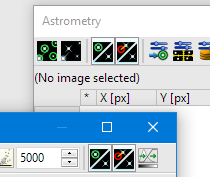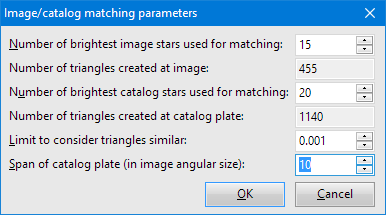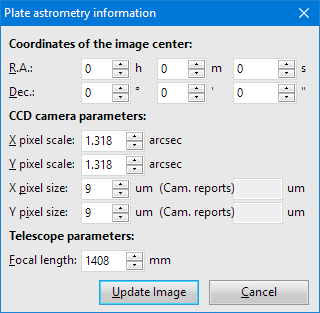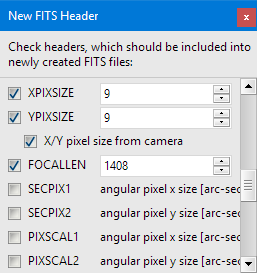Control of image overlays
SIPS v3.3 unified ways to control the astrometry-related
overlays displayed above the images in SIPS. In principle, it is
possible to highlight stars found within the image (with green
circles) and if the image is matched with catalog, corresponding
catalog star positions are marked with red circles and orange line
connecting green star circle with red catalog circle indicates the
match. The respective check-buttons, located in both Astrometry
and Photometry tool windows, are now synchronized and they state
applies to all images regardless if displayed in independent image
window or in other tools.

Astrometry and Photometry tools controlling image
overlays are now synchronized Astrometry with uncertain image center coordinates
Attention was paid to increase robustness of the astrometry
match when the image center coordinates are not know precisely.
SIPS v3.3 now can find proper match even if the image coordinates
are known only roughly, the uncertainty can be a multiply of the
image angular dimensions. It is enough to define span of the
catalog plate in the Image/catalog matching parameters dialog box
and SIPS searches much wider area when trying to match image and
catalog stars. Of course searching of much larger area needs some
time, but astrometry if optimized to be very fast so the match
need only a couple of seconds on typical PC.

Image/catalog matching parameters dialog box allow
definition of catalog plate span This functionality can be very useful for centering of the
target field in the case the mount cannot goto with enough
precision. The Astrometry tool allows syncing of the mount
controller with the detected image center coordinates, so the
target field can be found with much higher precision, especially
if the whole process involving astrometry match of the field and
mount syncing is repeated several times.
Photometry batch processing
Photometry processing can be time consuming (despite all
optimizations and parallel processing implemented in SIPS).
Especially finding of all stars on large images and the photometry
calculation for tens of thousands stars for every image need time.
Typically the user needs to invoke individual steps by separate
clicks (Find star and match images, Calculate astrometry,
Calculate photometry). New SIPS introduced a new command button
“Photometry Batch”, which performs all these steps in
series, so the user does not need to pay attention to the process
until all three steps finished.

Photometry Batch command button in the Photometry tool
bar Warning: Before using a batch processing, make sure all steps
can be performed without problems and errors. This means the star
searching parameters are correctly set so all stars within image
will be found, astrometry catalog is properly defined and plate
parameters lead to correct astrometry match etc. Automatic calculation of optimal aperture in
Photometry
Automatic calculation of the optimal aperture in the Photometry
tool requires propagation of the single resulting aperture value
through all images in the photometry series else the measured flux
may vary. But the unification of the aperture did not work
reliably in all cases in previous SIPS versions, sometimes
different aperture was used on a few images. Such measurements
have to be skipped or manually set aperture has to be used. SIPS
v3.3 fixed this problem and automatically calculated optimal
aperture is always used on all images.
Wider set of FITS headers
FITS files allow definition of any parameter in its header
(only a few parameters are obligatory), which makes the standard
very flexible, but at the same time this freedom leads to terrible
situations when multiple software packages need to cooperate.
Individual programmers chose arbitrary and mutually different
keywords for the same information. For instance image center
coordinates may be defined using RA and DEC keywords, but some
software packages use OBJCTRA and OBJCTDEC keywords, while other
packages use OBJRA and OBJDEC keywords. Pixel angular size si
similarly defined using PIXSCAL keyword, while SECPIX and SECPPIX
are also used. New alternative keywords are continually added to
every new version of SIPS to allow as wide interoperability as
possible. Reports of unsupported FITS keywords are welcome so they
support can be included into new SIPS versions.
Astrometry plate parameters calculation
While previous SIPS version required pixel angular size to be
defined prior to astrometry image solution, new SIPS version can
use the focal length and pixel physical dimensions to calculate
angular pixel size. Of course the Plate parameters dialog box
still allows explicit definition of these parameters:

Plate parameters dialog box If also the pixel physical dimensions and focal length of the
used telescope are undefined in the particular image, SIPS tries
to use default values for these parameters. These default values
are somewhat hidden in the New FITS Header tool window. But this
tool window has to be used if we want to include pixel physical
dimensions and focal length parameters into every acquired image,
so the user simply has to type these parameter values here.

New FITS Header tool window allows definition of pixel
dimension and focal length Hint: The “X/Y pixel size from camera” check box allows
automatic updating of these values from the connected camera each
time image is acquired. Because SIPS camera drivers have to
provide proper pixel dimensions, only the focal length must be
entered manually. SIPS is a freeware and can be downloaded from the Download section of this web site.
| 